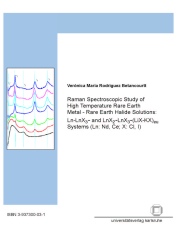Veroníca M Rodríguez Betancourtt
Raman spectroscopic study of high temperature rare earth metal-rare earth halide solutions: Ln-LnX3- and LnX2-LnX3-(LiX-KX)eu Systems (Ln: Nd, Ce; X: Cl, I)
In this work new Raman spectroscopic experiments on rare earth metal-rare earth trihalide melts (Ln-LnX3 and LnX2-LnX3: Ln=Ce, Nd; X=Cl, I) and their mixtures in alkali halide eutectic solvents ((LiX-KX)eu; X=Cl, I) are presented. The main results can be summarized as follows: – The Raman spectra of following trihalide systems have been measured for the first time: CeCl3, CeI3, NdI3 and their mixtures in the respective alkali halide eutectic solvent. The structure of the LnX3 in the solvent can be characterized by octahedral complexes. The force constants decrease from the chlorides to the iodides. – The Raman spectra of the following dihalides have been observed in this work: NdCl2, CeI2 and their mixtures in the alkali halide solvent. Interestingly, CeCl2 might form as intermediate species on doping CeCl3 with Ce. It is not a stable compound in the Ce-CeCl3 phase diagram. – With respect to the above mentioned main objective the following conclusions can be drawn: (i) On mixing of NdCl2 with NdCl3 in (LiCl-KCl)eu the undisturbed spectra of both components can be observed simultaneously. This is in agreement with the suggested intervalence charge transfer hopping mechanism if one assumes a hopping rate below 1012. (ii) Even though CeCl2 might form as intermediate, in the equilibrium spectra of liquid Ce-CeCl3-(LiCl-KCl)eu only the typical – 36 CeCl -octahedra can be identified. This supports the assumption that in these systems the electronic defect states are probably mobile Drude-like electrons which do not lead to new Raman detectable species. A qualitatively similar observation was made for CeI2-CeI3-(LiI-KI)eu melts.

